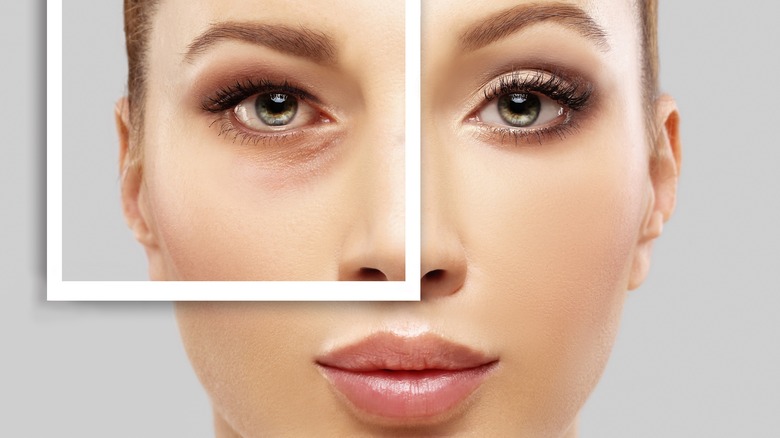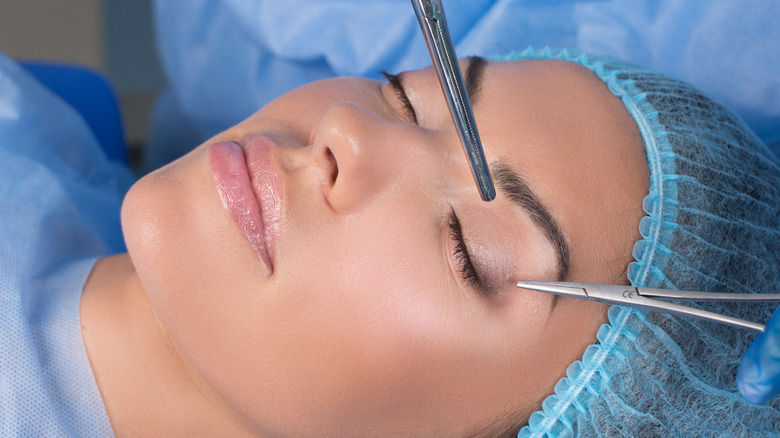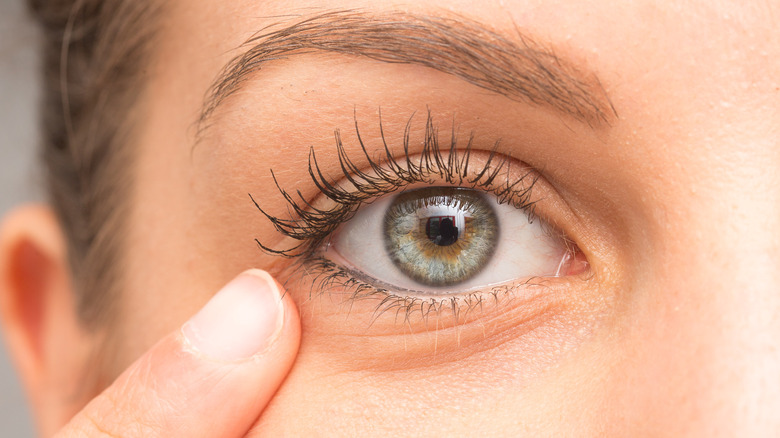The Trendy Micro-Procedure That's Aiming For Your Eyelids
Few areas of our body mirror our age like the eyes. The muscles and skin around our eyes begin to weaken and lose elasticity as we get older, giving them a saggy, sunken appearance accompanied by fatty bags under the lower eyelids. Not only do droopy eyelids make us look old, but they also obstruct our vision. Some people are born with droopy eyelids while some may develop them as a result of a medical condition. But for most of us, they are a part of aging. Fortunately, we don't have to live with that.
There are several non-invasive treatments that can help us remove the excess skin on our eyelids to make the eyes look younger, such as Botox, mesotherapy, eye fillers, and retinol application. All these procedures can help you achieve your eye-rejuvenating goal to a certain extent. However, if you're on the lookout for a micro-procedure that promises results that none of the aforementioned do, look no further than blepharoplasty. While the non-invasive techniques can give the skin around your eye a temporary lift and stretch for a more rested look, they cannot make a direct impact on the eyelids for an instant and lasting result like blepharoplasty. We can tell you upfront that blepharoplasty is not non-invasive and it's not for everyone. But that's probably the reason why it's a real game-changer.
Who can benefit from blepharoplasty
To reiterate — blepharoplasty is a surgical procedure that addresses both cosmetic and medical concerns. It rejuvenates the eye by removing excess fat and skin from the natural crease of the eyelid — a hidden-in-plain-sight area where scarring is not visible. Per the Eye Institute of Houston, blepharoplasty can be performed on both upper eyelids and lower eyelids. The surgery for the lower eyelid concentrates on removing puffy bags beneath the eyes, while the procedure for the upper eyelid involves eradicating excessively loose tissue to make it look tighter.
Aside from making the eyes look more youthful and alert, the surgery can also improve your vision. Compared to other non-invasive methods, blepharoplasty is more comprehensive.
The eyes are a complex area, so you'll have to meet with a plastic surgeon or an eye specialist to go over your medical history before undergoing surgery, according to Mayo Clinic. You'll be asked whether you suffer from diabetes, allergies, or eye issues. Along with these questions, your doctor will inquire about your diet and usage of medications and illicit substances. You'll also be put through an eye exam, visual field testing, and eyelid photography. Only after your surgeon has understood your eyes' anatomy, your state of health, and your goals, can they recommend the option that best suits you. If yours is a medical concern, you might qualify for the procedure as early as your 20s, though more commonly people in their 30, 40s, and older seek this procedure.
What happens during the procedure
Although eyelid surgery is often an outpatient procedure, you should have someone drive you home or spend the first night with you following the procedure for safety purposes. A few weeks leading to the surgery, your doctor may advise you to stop smoking and stop taking supplements and medications that contribute to bleeding, including things like aspirin, ibuprofen, and naproxen sodium according to the Mayo Clinic.
At the time of the procedure, your healthcare provider might put you under anesthesia to make you insensitive to the pain, per NHS. An upper lid surgery involves the surgeon making an incision along the upper eyelid crease, removing some extra skin and fat before stitching up the wound. In a lower lid surgery, the surgeon creates an incision within the lower lid and trims away extra fat to reduce the baggy look. After closing the incisions, the surgeon often places suture strips in the treated areas to stabilize the eyelids and you keep them on for about a week.
Lower lid surgery might take up to two hours, while an upper blepharoplasty could take around an hour. After spending some time in a recovery area where staff members keep an eye on your post-op complications, you can go home on the same day if everything pans out well. Depending on their eye anatomy and their goals, some people might require more than one blepharoplasty session.
What to expect from blepharoplasty
Different people might experience varying levels of discomfort and swelling after the procedure, but rest assured your physician will prescribe you some medications to manage the pain and offer essential aftercare tips to minimize an infection. After the procedure, you might temporarily experience watery eyes, light sensitivity, bruising, puffy eyelids, and scarring. However, they will go away after a couple of weeks and you'll start noticing visible improvements in the treated areas. More severe complications such as vision impairment, excessive bleeding, or eye infections are quite rare.
Here comes the million-dollar question: are blepharoplasty results permanent?
According to London Facial Plastic Surgery, a blepharoplasty session can yield results that last more than a decade. The results might be longer for people who put a lot of effort into maintaining their skin. Even though blepharoplasty is intended to provide you with long-lasting benefits, the skin around the eyes will still be affected by inevitable elements such as aging, sun exposure, and facial expressions.
Generally speaking, blepharoplasty is a low-risk surgery that helps improve the look of saggy eyes and corrects visual impairment to give you a boost of confidence. Plus, the results tend to be longer lasting so you don't have to go for touch-ups a few times a year like you have to with other non-invasive methods.



